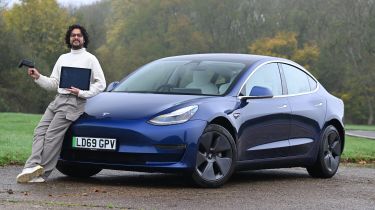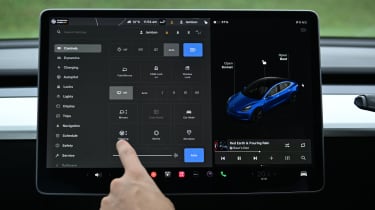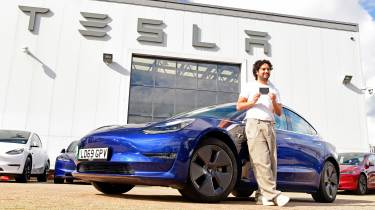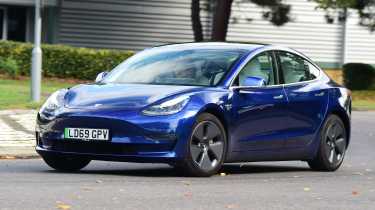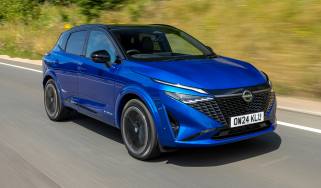Used Tesla Model 3 Dual Motor long-term test: five-year-old EV still feels bang up to date
Second report: we’re getting to grips with the screen that controls everything

Verdict
The Model 3’s user interface has stood the test of time, showing up many newer rivals with how easy it is to use – once you get used to it. It adds to a car that’s brilliantly capable, especially as a second-hand buy.
- Mileage: 64,825
- Efficiency: 3.9mi/kWh
It's not unheard of for car makers to try to identify as a tech companies, but if there’s one that actually fits the bill, it would probably be Tesla.
Since the first Model S, it has been doing everything differently, and while there are some elements of a modern Tesla that seem initially challenging, we’ve found that when it comes to the user interface, the American brand is really on to something.
In the past, when driving a Tesla for short periods, it was difficult to wrap our heads around the quirks of the system. But after a longer stint in our Model 3, I have to say that a lot of it just makes plain good sense – and that’s coming from a fierce supporter of the traditional knob or button.
Obviously, the main interface within a Tesla Model 3’s interior is the touchscreen, which we still think is one of the best in the business. Our car, remember, is now around five years old and yet it doesn’t feel even remotely out of date. In fact, it’s still very much a leader in the segment.
More reviews
Car group tests
- Polestar 2 vs Tesla Model 3 twin test review: EV titans go head-to-head
- BMW i4 vs Polestar 2 vs Tesla Model 3: 2022 group test review
- Ford Mustang Mach-E vs Tesla Model 3
In-depth reviews
Road tests
- New Tesla Model 3 Performance 2024 review: a capable EV that’s ferociously fast
- Tesla Model 3 2023 facelift review: so much more than just a new face
- New Tesla Model 3 Standard Range Plus 2020 review
Used car tests
To start with, simple tasks such as listening to music or changing the temperature on the climate control are easy and accessible from the main screen. If you want more detail, you press that section of the screen and new options will open up in a floating window.
As an avid listener to Apple Music, I don’t need to use my phone and connect it through the system. That means the app is embedded into the interface, and with my login connected, all the music and playlists on my other devices are available in the car. The same goes for Spotify, or podcast apps.
There’s been lots of controversy about elements such as the adjustment controls for the door mirrors and steering column being controlled through the screen, but in actual fact this isn’t really an issue.
Once chosen, the left-hand steering wheel roller controls change function to adjust either the mirrors or steering column, and work brilliantly. Their functions extend even further, because a tap of the left stalk opens up a menu for the wipers. Activate cruise control and the one on the right can tweak the distance to the car ahead with a left or right push, and the speed with the roller.
Once any of these settings have been changed, you shouldn’t ever need to alter them. As in some new cars, the Model 3 has specific driver profiles stored, which means that if you select the right person, all adjustable elements controlled through the screen are set for them. And if you change them on the move, you’re given an option to save them or not. Very clever.
With some familiarisation, then, all the Tesla’s touchpoints become second nature, feeling closer to the iPads and PlayStation controllers that we’ve been using over the past couple of decades than anything as clumsy as a small car touchscreen.
Fleetwatch
We’ve been taking advantage of Tesla’s Supercharger network. Despite often not quite reaching the incredible speeds some chargers are capable of, its ease, availability and reliability take away all the stress of charging on the go. It’s also relatively affordable, with prices variable depending on the day, but generally costing just over half that of an equivalently powerful charger. So far the best thing about having a Tesla has nothing to do with the car at all.
Used Tesla Model 3 Dual Motor: first report
A 2019 version of Tesla’s best-seller joins our fleet - but how is it holding up?
- Mileage: 63,400
- Efficiency: TBC
How times change. It feels like only yesterday that people were climbing over barbed wire fences to get a hold of an electric car. But now, not only are waiting times coming down, but there’s also a knock-on effect of lowering prices in the rapidly growing used electric car market.
With this in mind, the question of whether it’s a good idea to take the plunge on a second-hand example is becoming more relevant. But how can we find out? Well, as one of the biggest-selling EV brands in Europe over the last few years, Tesla is a great place to start, and with its Certified Pre-Owned (CPO) vehicle service now operational, it’s a chance for us to see what sort of service the firm offers.
Our 69-plate Model 3 will be with us for the next few months and over that time we’ll be answering the series of questions that you, and we, have been asking. This includes how build quality has held up and how well the battery and motors have lasted.
Our example is a 2019 car with the top-spec high-output motors, but is not an official ‘Performance’ model, so doesn’t feature its chassis tweaks or bigger brakes. The only visual cue that our car is packing serious power is a red line under the dual-motor badge. Even its wheels are the basic 18-inch aero-spec rims found on the standard car.
It has done some 63,000 miles, and comes with an ambitiously bright white interior. Yet on first glance, everything looks surprisingly good in terms of wear and tear. Of course, this may well have something to do with the fact that all of Tesla’s CPO models undergo a comprehensive checkover and refurbishment before reaching a new customer.
To get a sense of what this entails, we were shown around one of Tesla’s CPO centres and ran through the process leading up to handover. The operation starts by selecting the car itself: it has to have less than 90,000 miles and be in good condition.
Small bumps and scrapes are fine – these can be tidied in-house – but cars with any more than that won’t be accepted in the scheme, ensuring that a sales vehicle is up to standard and has no major damage. It also comes with an additional one-year or 10,000-mile warranty from the date of delivery, if it’s outside the four-year, 50,000-mile factory cover. Battery and drive units are covered for eight years or 150,000 miles, both of which are over the statutes for CPO vehicles.
Our car does have the usual stone chips, scratches and blemishes you’d expect of any five-year-old model with over 60,000 miles, but is in good order inside and has aged well. The minimalist interior means there’s very little in the cabin that looks or feels worn. Even the gloss centre console is blemish-free.
There are other advantages to running a Tesla as a second-hand buy, and that’s got a lot to do with how the car was designed from the outset to adopt over-the-air updates. This also means that, where fitted, most of the latest autonomous driving functions are in play, such as Tesla’s Autopilot system. We also have full access to the Tesla app, which gives us a virtual key via the iPhone app, plus the ability to pre-plan trips and pre-condition the cabin – we’re particularly looking forward to that one as winter nights draw in.
There’s a final bonus in our pre-2023 car compared to newer versions, too, in that it has a traditional set of indicator stalks and a gear selector – unlike the latest Model 3. Arguably, though, the best part of owning a Tesla is access to the Supercharger network, which continues to be the best in the business in terms of charging rate, cost and ease of use.
On the road, first impressions are good. The ride is firm and the steering a bit short on feel, but the car remains incredibly powerful after 63,000 miles, with an immense turn of speed.
For the £21,500 value of our Model 3, you could instead find yourself in a slightly older BMW 340i or an Audi S4 with similar mileage, less performance and probably much higher running costs. But the question is, do either of those feel quite as modern as the Model 3?
There’s only one way to find out. And over the next few months, as we live with ours, we’ll be able to tell you for definite whether a used Tesla is likely to be the biggest boom – or bust – in the used-car market.
| Rating: | 4.0 stars |
| Model: | Tesla Model 3 Dual Motor |
| On fleet since: | August 2024 |
| Price new: | £56,490 |
| Price now: | £21,500 |
| Powertrain: | 75kWh battery, 2x e-motor, 444bhp |
| CO2/BiK: | 0g/km/2% |
| Options: | None |
| Insurance: | Group: 50/Quote: £713 |
| Mileage: | 64,825 |
| Any problems? | None so far |

